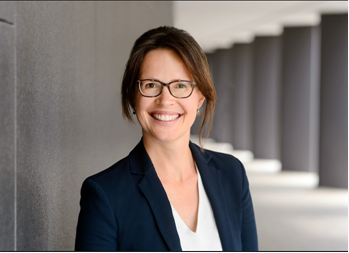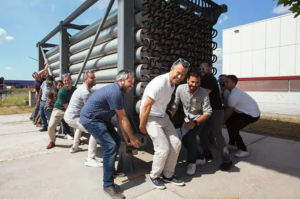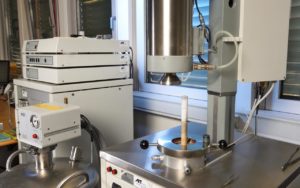“There is a great deal of experience with solid-media high-temperature storages”
March 4, 2024
The German Aerospace Center (DLR) develops thermal storage solutions and collaborates actively with a number of startups and manufacturers in the field of high-temperature storage. Annelies Vandersickel, Head of the Department Thermal Process Technology at the DLR is one of the institute’s dedicated experts on thermal energy storage technology. We talked with her about the challenges in developing and implementing solid-media high-temperature thermal storage and how to make data on storage capacities and losses comparable. Vandersickel is also a professor at the University of Stuttgart in the field of thermal energy storage.
Photo: German Aerospace Center
A new industry for high-temperature storage is currently emerging. Most companies use solids as a storage medium. What long-term experience has been gained with solid-media high-temperature storage systems?
Vandersickel: Steelworks have been using so-called regenerator storage systems since the 1860s. These are usually stacked ceramic bricks with holes through which the hot furnace gases are channelled for charging. The next time the furnaces are started up, the heat is first extracted from the storage system by passing air through the bricks. The system is usually run in short cycles of 20 to 180 minutes. A lot of research has been carried out on this application of regenerator storage and models have been developed. So there is already a great deal of experience both in research and in practice with solid-media high-temperature storage.
But the application is new. The many start-ups are aiming to decarbonize industrial heating.
Vandersickel: Exactly. The requirement to avoid fossil fuels in industrial heating has given high-temperature storage systems a new market opportunity. It is predominantly container solutions that are now being offered, i.e. smaller storage capacities in the single-digit MWh range.
However, when it comes to decarbonizing industrial sites and heating plants, we are talking about storage systems in the three-digit MWh range. This is where modular storage systems reach their limits and large-scale storage designs are required.
In the context of energy transition, there is also a need to store large amounts of energy efficiently for longer periods of time, i.e. over several days, in order to bridge periods when there is little wind or sun and therefore not enough regenerative electricity available. The newly emerging storage industry offers solutions for both – short-term storage of a few hours and long-term storage in large-scale systems over several days.
“Storage system suppliers need to reduce the costs”
What are the challenges in the development of new solid-media storage systems?
Vandersickel: In principle, solid-media storage systems are a simple technology, which – as just described – has been in use for some time in certain applications such as steel production. Nevertheless, there are challenges at various levels. Storage providers need to have a good understanding of the thermodynamic processes involved in charging and discharging and get to grips with the thermal expansion coefficients between the heat exchangers and the storage material.
In the case of storage media with a lower thermal conductivity such as sand, rocks or bricks, for example, a thermal front moves through the material from one side to the other during loading. This creates thermomechanical stresses in the storage unit, which must be brought under control. In addition, when unloading the temperature drops as soon as the thermal front reaches the outlet, which means that – depending on the process – not 100 % of the stored energy can actually be utilized.
However, storage system suppliers also need to reduce the costs. The problem here is not so much the storage material, as there are many cheap materials available. Rather, the loading and unloading infrastructure as well as the insulation and the container cost more than half of the total expenditure.
So the costs are also driven up because most power-to-heat storage systems have two separate heat exchanger circuits for charging and discharging?
Vandersickel: The decision on the design of the storage system depends heavily on the application. In a batch process, you can charge and then discharge the storage with the same heat exchanger.
For industrially utilized high-temperature storage, however, it can also be advantageous if charging and discharging can take place simultaneously. These storage units are, for example, charged via electrically heated air and at the same time they provide steam to the industrial customer. For this the storage requires two separate heat exchangers, which increases the construction costs.
Not all storage system suppliers have the confidence to generate the steam directly in the heat exchanger in the storage unit as this is challenging in terms of control technology. In the transition from water to steam, the heat-transfer medium draws a lot of energy from the storage at certain points, after which the heat transfer coefficients drop sharply and the heat can no longer be effectively extracted from the storage. In this case, industrial customers can also choose a simpler design that charges and discharges via one air heat exchanger. A downstream steam generator is then required.
“Operating conditions significantly influence the actual usable heat capacity”
Very different storage materials are used – sometimes sand or stones, sometimes cement blocks or even steel, all of which have different storage capacities. So how can the storage capacities of demonstration plants be compared with each other?
Vandersickel: Basically, when specifying a storage capacity in MWh, the temperature spread to which the capacity refers should also be specified. In addition to the heat capacity of the storage material, the operating conditions also have a major influence on the storage capacity.
An installed storage unit therefore always has a maximum storage capacity, which is reached when it is fully charged. Here, the difference to the ambient temperature is usually taken into account for the temperature spread.
However, the operating conditions significantly influence the actual usable heat capacity. So if the unit is heated to 600 °C but the customer requires steam at 300 °C, then the storage can only be discharged to 310 °C. In this case, the usable storage capacity is therefore less than half of the maximum possible storage capacity. Added to this is the heat of fusion if the storage medium is a so-called phase-change material, which performs a phase change that stores additional heat.
Storage manufacturers like to emphasize that their storage systems are over 90 % efficient despite the high temperatures. Is that a realistic figure?
Vandersickel: When it comes to efficiency, you always have to say what time period the losses relate to and where the system limit is. For example, in a power-to-heat system, is the electric heater for charging or auxiliary energy for fans, pumps etc. included in the losses or do the losses only relate to the storage unit without the charging process? In our experience, the losses are 1 to 10 % per day if temperatures between 500 and 1,500 °C are stored.
However, when assessing the acceptability of storage system losses, it is also important to clarify how long the storage can maintain the desired temperature for the customer during unloading. If my storage unit can be charged up to 600 °C but the industrial customer only needs thermal energy at 250 °C, then I can accept losses of 5 % over several days because the maximum temperature of the storage can drop but it can still provide the customer with 250 °C temperature. Whether this is worthwhile is then more of an economic question.
Websites of organizations mentioned in this news article:
https://www.dlr.de/en


